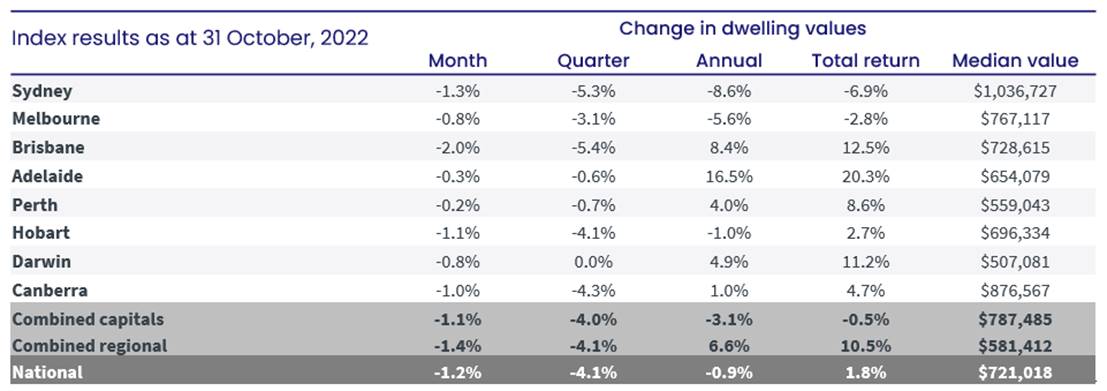Six months of falls for Australia’s residential property market - CoreLogic
Contact
Six months of falls for Australia’s residential property market - CoreLogic
The geographic scope of Australia’s housing downturn broadened through October with every capital city and rest-of-state region (apart from regional South Australia) recording a drop in housing values last month.
The geographic scope of Australia’s housing downturn broadened through October with every capital city and rest-of-state region (apart from regional South Australia) recording a drop in housing values last month.
The CoreLogic’s national Home Value Index (HVI) moved through sixth months of consistent declines, as values fell a further -1.2% in October.
Across the capital cities the month-on-month decline ranged from a -2.0% fall in Brisbane to Perth where dwelling values nudged -0.2% lower. Across the rest-of-state regions, monthly falls of more than -1% were recorded in Regional NSW (-1.7%), Regional Victoria (-1.4%) and Regional Queensland (-1.3%).
Although more regions are recording a fall in housing values, the rate of declines remain diverse. The pace of falls has eased over the past two months across Sydney and past three months in Melbourne but has gathered momentum in Brisbane where home values are now falling the most rapidly of any capital city or rest-of-state region. The changing dynamic across the largest cities has seen the rate of decline across the combined capitals index ease from a -1.6% drop in August to -1.4% in September and -1.2% in October.
CoreLogic’s Research Director, Tim Lawless said it is probably still too early to claim the worst of the decline phase is over.
“Despite the easing in the pace of decline, with Australian borrowers facing the double whammy of further interest rate hikes along with persistently high and rising inflation, there is a genuine risk we could see the rate of decline re-accelerate as interest rates rise further and household balance sheets become more thinly stretched,” he said.
“To-date, the housing downturn has remained orderly, at least in the context of the significant upswing in values. This is supported by a below-average flow of new listings that is keeping overall inventory levels contained. There’s also tight labour market conditions, an accrual of borrower savings and a larger than normal cohort of fixed interest rate borrowers, who have so far been insulated from the rapid rise in interest rates.”
Housing values across most of the broad regions remain well above pre-COVID levels, implying most home owners remain in a positive valuation position relative to their purchase price.
At the combined capital city level, housing values have fallen -6.5% following a 25.5% rise through the upswing. Sydney home values are down -10.2% since peaking in January (after a 27.7% rise) and Melbourne values down -6.4% since February (after rising 17.3%).
Across the 310 SA3 sub-regions analysed nationally (excluding areas with low sales or low confidence scores), only 16 regions remained at cyclical highs at the end of October, with a skew towards the more affordable areas of Perth and Adelaide and a mix of regional markets.
House values have continued to fall at a faster rate than unit values across most regions. Capital city house values were down -1.2% in October compared with a -0.7% decline in unit values. This underperformance across the lower density sector has been a feature of the downturn, partially offsetting the substantially larger rise in house values through the growth phase.
Through the upswing, capital city house values increased by 29.9% which was more than double the rise in unit values at 13.2%. Since peaking in April, capital city house values have reduced by -7.2% while unit values are down -4.2%.
Mr Lawless said the smaller decline in values across the unit sector can be attributed to the more affordable price points across the medium to high density sector.
“The gap between median house and unit values increased to record levels through the COVID upswing. With borrowing capacity being hit hard as interest rates rise, it’s likely more housing demand has been diverted towards more affordable sectors of the market,” he said.






